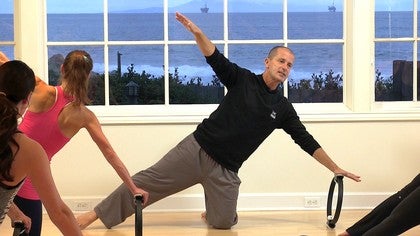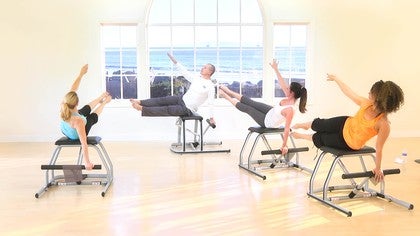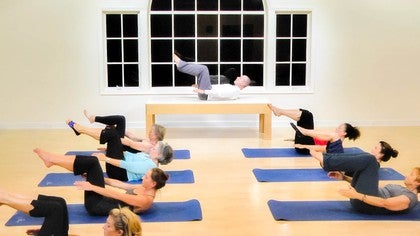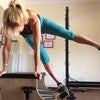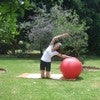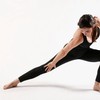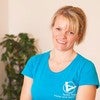Description
About This Video
Transcript
Read Full Transcript
We're going to do the mat this evening. I always taught all my classes standing. And I finish my classes standing because I believe that what we're doing on the mat is to train us to stand better. So what I want you to do is stand behind your mat. Stand on the wooden floor.
And what I want you to think about first is your feet. Feel the connection with the ground. Really push the feet into the ground and think about those feet. So your little toe, your big toe is touching the floor evenly. From that pressure pushing down, use the opposition of force of lengthening the spine up.
So really elongate the spine. Go ahead and take a breath in. Take a breath in through your nose. And as you breathe out through your mouth, make the spine get longer. So breathe out and lengthen the spine a little bit longer.
Again, take a breath in. And as you breathe out, lengthen the spine. Now, just check the pelvis. Put the pelvis in a good position. I don't like to talk to you just about neutral or natural, but just in a good position.
So it's not tilting forward or tilting back, just hang in a good alignment. And then just connect those deeper stabilizing muscles to hold it, so in a very good solid position. Taking a breath in, keeping that still. And as you breathe out, let's get started. Use your breath.
And breathe out, breathe in, and breathe out. Now, slowly, keep what we've got, push up onto your toes, and slowly come back down. Again, breathing out as you lift up. So the back is stable. You'll lengthen the spine like elastic.
One more time. Breathe out and breathe in. Let's add the arms with this movement. So we're going to go up, breathing out. As you go up, your shoulders drop down.
Again, breathe out and breathe in. Now, flex the spine, curve, and come back to that position. Again, breathe out and breathe in. Try and sense where that pelvis is. Keep going through the body.
Think about the shoulders, think about the spine. Using your breath-- breathe out and breathe in. Let's put that together. So balance up, push up, center. Slowly come down.
Flex forward, curve, and reaching out. One more time. Breathe out, preparing the body for the training we're going to do on the mat. Breathe out, push, and lift up. Now, let's take this a little bit deeper.
Take the hands behind the legs. Wrap the hands behind. And then coming up, lift the arms up, and open the arms out. Again, curve the spine, wrap behind the legs. Get as low as you can and lengthen up.
Lifting up and open out. Breathing out, curve back, round down, and lengthen up. So keep checking the center. Check the shoulders. One more time, curve back, breathe out, and breathe in.
Lifting up and down. Now, bring the body stable. One more thing before we stop, we're going to circle the arms up and back. Shoulders stay down, the body's still. So just your arms opening, open that shoulder, lengthen out.
A little bit bigger each time, sense the ribcage is held. Breathe out, push out, open back, push. Four more times. Circle back and lengthen out. Push out, reach.
Now, let's make it a bit more localized. Circle just the scapula. Lift up, squeeze back. So it's been a bad day or tense day, get rid of all that tension out of the shoulders and push up. Push, breathe out, squeeze, and back, lengthen up.
This time, drop them down, but put them into place. Now, slowly roll down to the mat. Slowly roll up, take a breath in, and breathe out. Slowly roll down. Slowly roll up, lift up.
One last time, roll down. Slowly roll up, center, and lifting up. Good. Now, we're going go to the mat. So roll down to your mat.
Bend your knees. Come to the side. Sit on the mat. Sit on the hips. Now, let's put the feet all to the same direction.
So we put the feet to the side. We're going to start lying down on the mat. Bend the underneath leg up. Now, the top leg is in line with the hip. Take the top arm out.
And gently, as you breathe out, stretch the leg away. Take a breath in. And again, as you breathe out, stretch the leg away and breathe in. Again, stretch, breathe out and breathe in. One more, this time, lengthen.
Now, keep the length, point the toe. And we're going to start circling the leg, but take the leg behind the pelvis. Now, keep circling. Think about the waist underneath. So your waist is lifted.
Explore the movement. Keep that ribcage held. Using your breath, circle the leg. Breathe in, breathe out. One breath to each circle.
Take it far back, feel the lengthening. Close the center. Hold that center. Now, let's reverse the circle. Circle the other direction.
Breathe in and breathe out. Keep the arm lengthening. Keep the shoulder down. Imagine if you're a camera looking down from the ceiling, your shoulders are stacked on top of each other, your pelvis is stacked on top of each other. Feel the lengthening to the top of the thigh.
Make it longer. As the legs get very tired with what we have to do during the day, we want to get that muscle long. Hold the center, taking a breath in and breathing out and slowly bend those knees. Come to a sitting position. Let's do that on the other side.
Lengthen out. So on to the mat, bend the underneath leg. Now, stretch the leg long, pull the arm, take a breath in-- just about five times. As you breathe out, make the leg longer. Again, breathe in.
As you breathe out, make the leg longer, stretch, and push. Again, breathe in. As you breathe out, lengthen the leg. Now, keep that length. Start circling, remember behind the pelvis.
Without moving that torso, hold the center. How far can you get that leg behind? Breathe in and breathe out. Lengthen out. Just check the shoulder is not pulled up.
Check the shoulders are down, make the spine long. Just like we did in the beginning of the class, lengthen the spine out. Breathe in through your nose. And breathe out through the mouth. Let's reverse the circle, other direction.
Remember it is a circle. Point the toe. It's like you're drawing a circle with that big toe. Imagine where the circle would be on the wall. Try and take it behind you.
Breathe in, breathe out, breathe in. Breathing out, push away, lengthen. Just four more. Push out, lengthen, open out. Good.
Two more. And slowly relax those legs. Lie on your back and bend those knees. And now, with the knees bent, I want you to find the position of the pelvis. So the pelvis is level in a neutral alignment.
Lift your arms up to the ceiling. Lift your shoulders. And then drop the shoulders back down. Now, bring the arms down to the side. Now, hold this position still.
This is what we call an active rest position. We're holding it. But to engage those muscles, feel like the muscles are wrapping from the back around to the front like a corset hugging you. So we're switching on those deep stabilizers. Think about working two sets of muscles.
The muscles are the deepest sets of muscles, which are very gentle to train, and then obviously, the most superficial muscles which we use a lot. So here, we're just switching on those deeper muscles. Now, keeping the lower back so there's a little space under the back. It's almost like air is passing underneath. Don't move anything.
Keep the shoulders engaged. As you breathe out, slope one leg up to tabletop position, just so the knee is above the hip. Now, nothing's changed. We're still focusing on those deep stabilizers. Take a breath in through your nose.
And as you're breathing out-- I like to use a lot of visualizations. And here, I like to imagine that a butterfly has just landed on your navel, and you don't want to disturb it. Breathe in and breathing out. Now slowly place that foot down. Let's try the other side.
Keep the back stable, lift the other leg up. Remember, using those deep stabilizers, we're either working from the pelvic floor or gently pulling that navel to spine, pulling that transversus, and switching it on like a big corset muscle. One or the other, don't use both. And now, slowly take the foot down to the mat. Now, from this position, we're going to tilt the pelvis, roll the spine up, and lift the pelvis up into a ski-slope position.
Take a breath at the top, breathing in. As you breathe out, roll the spine down, articulate the spine. And at the very bottom, take the pelvis back to that neutral position. Let's do that again, breathing out as you lift up. It's the first part of the shoulder bridge movement.
And we're using it just to mobilize the spine. Take a breath in. As you breathe out, roll the spine down, vertebrae by vertebrae. And lengthen the spine, lengthen. Pelvis down to the bottom, take a breath in.
Now, we're still using those deep stabilizers, so make sure they're working with the glutes as you lift up. So roll up. So core muscle, glutes are switched on. Don't let one work more than the other. Slowly rolling down, articulate the spine.
Bring it back down to neutral position. Again, breathing in and breathing out, roll the pelvis out-- glutes and core working together. At the top of the movement, feel the thighs long. Check the shoulders. Roll the spine down.
Roll all the way back to neutral. Let's just do two more of this. Breathing out and rolling up, try not to push on the arms too much with your hands on the floor. So the arms are relaxed. And then slowly rolling down.
One more time, breathing in. And as you're breathing out, roll the spine up. And then slowly roll the spine down and come back to that neutral alignment. Now, from this position, lift your arms up. Keep the scapula and the shoulder blades down the back.
And just gently now, lift the head and shoulders off the floor. But I want to feel the base of the scapula touching the mat, so don't lift it too high. And then come back down. Take a breath in. As you breathe out, lift the head and shoulders.
And just lift up so your base of the scapula is still touching the floor. And then coming back down. Now, the lower back is imprinting. So as you lift the head and shoulders, imprint the lower back, but it's very soft. As we lift the head and shoulders and then take it back down, we're using not just those deep stabilizers, but we're using the two sets of muscles.
So breathe out, lift up. Use the two sets of muscles. Don't let the top set push out. Hold and down. Now, this next time, lift up and hold it up.
Breathing out, lift the head and shoulders. Now, from here, think about the gentleness of the back touching the mat. It's very soft. As you breathe out, lift one leg up, keeping the tension soft. So I don't want you to push more into the mat.
Scapula is touching. Now, as you breathe in, breathe out and lift the second leg. Hold the second leg up. Now, take the first leg back down, take the second leg back down, and then take the head and shoulders down. So we're building the movement very logically.
Switch on the stabilizers, lift the head and shoulder. Now, back is gentle, scapula touching. Try not to lift up too much. Lift up one leg without increasing the tension on the back. Lift the second leg, don't increase the tension.
Breathing in, breathing out, lower the first leg down. Hold that center. And then slowly take the second leg and take the head and shoulders down. At any stage, if you feel there's too much in the neck, you can continue with the head and shoulders down, and the back in neutral. Let's try one more time.
Head and shoulders up. Now, connect the center. Breathing out, lift one leg. Don't push the back into the mat anymore. Breathe in.
As you lift second leg, breathing out. Now, from here, we're going to stay here. We're going to start with the 100, but we're going to start with the knees flexed. Take a breath in for five, in. And slowly breathing out for five, without the arms moving first.
Again, breathe in. Now, as you're doing it, think of the back. Think of the scapula. Keep the spine long. Watch the head position.
Breathe in. Five counts to breathe in. Five counts to breathe out. Soften the elbows. Keep the shoulders down.
Two more times. Breathe in. Slowly breathe out. Use those sets of muscles, work them together. One more time.
And now, slowly put one leg down. Slowly lower the second leg. And then take the head and shoulders down. Let's go back to the shoulder bridge preparation. Roll the spine up.
But this time, stay up. Take your thumb and finger and measure the gap underneath the glutes. Just gently, just place your hands there to keep the gap. You are using it as a sense. So sense that space with the fingers.
And then as you breathe out, lift one leg. Breathing in, take the leg down. Take it out, breathe out. Lift the second leg. Breathing in, take the hands out and slowly roll down, all the way down, back to the base position.
Again, breathing in and breathing out, roll the spine up. Now, find the gap. Measure the gap behind. Take a breath in. As you breathe out, lift one leg, tabletop.
Breathe in, lower the leg. As you breathe out, lift the other leg, shoulders down. Slowly take the leg down, take the hands out. And slowly roll the spine down, all the way down, all the way. Pelvis back to neutral.
Again, roll the spine out-- fluid movement. Think of the principles of Pilates. Control. Hands behind. Breathe in.
As you breathe out, use precision. Lift one leg. Take the leg down, breathe in. Breathing out, lift the other leg. Slowly place the leg, take the hands out, and then slowly roll down.
Let's progress this now. So roll up. Now, I don't want you to use your hands unless you need them. So roll up, find the space, but then keep the space. This time, lift one leg up, bend the knee first.
And now, stretch the legs to the ceiling. Push up, change legs, other side. Slowly lift the other leg, breathing out as you lengthen up, push. Slowly bend and roll down. This next time, as you roll the pelvis up, lift the arms up as well.
So arms up to the ceiling. Now, lift up, hold it there. Now, be clean, lift one leg up to the ceiling, up. Now, this time, reach the leg away, stretch it to the side. Lift it back up, change legs.
Use your breath-- breathing out to lift the leg up, take a breath in. Breathing out, power the body with the breath. Breathing in, lift up and change legs and roll the spine down. Roll, roll all the way down. And come back with the arms down.
Let's lift up again. This time, rolling up. Remember the deep muscles, those stabilizers we are focusing on are working with the superficial. Use them both. Lift the arms up.
Now, lift the leg up, take a breath in. This time, breathe out, reach the leg away. Lift the leg back up. Let's do the same leg again, push away, lengthen, reaching up. Keep the height of the pelvis.
Push up, center, push away, lengthen, reaching up. One more time. Lengthen, reaching up, and change legs. Lift up, pelvis stable, push up, reach, and lengthen. Push away, up, lengthen.
Good. Long spine. Center. Watch the ribcage, don't arch the back. Don't let the work go into the back muscles.
Keep the back and center working together. Reaching out, lift up. One more time. Push up slowly. Bring the leg down and roll the spine down.
This next time, we're going to ask you, just try it with your heels lifted as well. If you feel it goes too much into the calf or the back of the legs, just continue with the feet flat. So roll up first. Now, as you go to the top the movement, then lift the heels. Now, lift the heels, but keep the ankles fixed.
Don't let the ankles open. So the distance between the knees and the distance between the ankles stays the same. Lift the arms up. Center. Now, lift one leg up to the ceiling, push up.
Now, stretch the leg out and lift up. Again, push away, lengthen. Keep the pelvis up and lift. Breathing in, breathing out, pelvis lifted, push up. Good.
Let's change legs. And change, other side. Center. Lengthen up, push away, push, reach. Again, out, push.
Good. Make it long, make the thigh long. Remember the feeling of the leg circle. Stretch the top of the thigh. Push, reach up, and bend the knees.
And slowly roll down and pull the knees toward you. Turn to face me, on to the side, and come up on the elbow. Now, from here, bring the knees together, push the pelvis away. Bring the elbow underneath the ribcage. You can start by pushing that pelvis away, just get that lengthening.
And then lift the rib cage. With your top hand, put it underneath your head and just check the head is in the right place. So it's not tensing, lifting up. It's not dropping down. So you got the head on the spine.
Now, connect to the center, watch the ribcage. Slowly breathe out, lift up. And slowly breathe in and lift up. Now, it's like a piece of string is lifting you to the ceiling. Your back is sliding up the wall behind you.
And push up. I sometimes say it's a little bit like you're cleaning your patio doors with your bottom, with your glutes. So slide up, slide up, push. Another, you're not rolling forward. Again, push up, breathing out.
Long spine. Keep those legs together. Center. Breathe out, push, lengthen. This is one of the lower levels of the side-bend movement.
We're pushing up. Think about the underneath muscles. This is under flexors here. These lateral flexors were working. So like a book closing, as you lift up, close the waist underneath.
Close the waist, close, close, and come down. One more time. Lift up, push up, reach. And slowly come down. Now, lift up onto the arm.
Stretch the arm straight. Now, take the opposite arm, the left arm, put it over. Put the arm around underneath. Now, from here, we're going to listen to the mat. We're going to go down, listen to the mat, and lengthen.
Push down. Again, down and lengthen, but use your shoulders. As you go down, stretch the top leg and push up. Again, breathing out, breathing in. Again, breathing out.
Let's progress it. Stretch both legs, push out, long. Legs together, push. Again, reach and push out, lift. Two more.
Push. One more time. Up, lift up, and stretch out. Let's stay on the same side. And we'll start the movement lying down first.
It's the clam movement. So put your heels, your pelvis, and your back in a straight line. The underneath waist is lifted again. Now, underneath leg is pushing down. The top the leg opens out.
Wrap the leg around and come back, breathing out and down. Again, wrap the leg. Now, the head and shoulders are relaxed but long. Center connected, breathing out. Again, open out and lengthen.
Breathe out. Now, if you can-- you've got a choice here-- either continue right here or come back up on the elbow. So it's your choice. If this gets too much for the shoulder, go back down. Now, let's add the arm.
Push up, lift up, reach up. Try not to let the pelvis drop back. Your pelvis is forward. Now, from here, parallel, lift up. Parallel, breath out, ribcage lifted.
That's it. Remember, relaxed faces, work the center, breathe out, push. Now, lift up, reach, ribcage. That's it. Shoulders down.
Push and lengthen out. Let's alternate-- one open, open; one parallel, up. One open. Wrap the leg around. If you imagine cling film on the top of the leg, cling film as you open out, lift up, reach, wrap the muscles.
Open out. Now, the arm stays down on parallel. Open out, reach out, push out, lift up. One more time. This is a clam variation.
This time, lift the leg halfway, flex the foot. Now, small movement. Push, push, lengthen, reach. Now, small movement. Push, lift the shoulder, center.
Let's go up for four counts. Go up-- four, two, three. Gentle, down for four. Down, center, breathe out. Again, check the head and shoulders.
Don't let the tension creep in here; well, not in the neck and shoulders anyway. You can have tension in the back of the legs. You want it there, pushing out. Now, good, bring it forward for four. Forward, four.
Up, cling, two, three. Take it back for four. Up, gentle exercise. Push. Nice, relaxed faces.
Push out, breathe. It's like if somebody was walking past the window behind, you will make it look very easy. Take it back, push up. Now, let's give it a little walk. Up for four.
Up for four. Up, two, lengthen out. Gentle music, gentle exercise. Along the top for four. Four-- stay up on the top.
Ah, here. Try not to take your eyebrows up, just your leg. Take the leg down. That's it. The eyebrows stay down.
Take it long on four. Four, breathe, breathe. We're going to reverse. Along the bottom for four. It's the last one.
Four, four. Bring the pelvis up forward, at it. Now, up for four, up. Four, three, two. Along the top, take it along the top.
Top, two, three. Take it down for four. We're there. We're there. Four, three, two, and relax coming out.
Let's do other side. [MUSIC PLAYING] Now, we have to do the other side just as well to balance the body. If we only do one side, we'll get very strange glute on one side and not so good on the other side. So elbow first, we're going to the side bend first. There's three movements we're doing.
Legs together, center, shoulder down, long spine. Now, prepare the body, breathe out and slowly down. Again, push up and slowly down. So with this modified side bend, it's less work but still some work on the scapular shoulder. But I really want you to focus on that waist.
Think of closing the waist, close the book, close, close. And then slowly open out. So it's not the top of the body that's working but the underneath of the body. Lengthen. Two more.
Breathe out and lengthen up. One more time. Push up and slowly come down. Come up, cross the arm over. Cross this arm over and underneath.
Now, let us switch arms, so other arm is crossed. That's it. There we go. That's it. Change arms.
There, perfect. Listen to the mat. Listen and push. Breathe. And that's it, check up.
So what is the mat saying? Listen to it, go. Get as close as you can. It's whispering to you. Listen and up.
And come all the way up, down, good center. Now, as you go down, stretch the leg. Stretch, come up, bend the knee. Stretch. Long spine, spine, push.
Let's do four more with both legs, if you can. Stretch, go. Push, lift up. Push, lift up, push. One more time.
Breathe and lift up and take it down. Let's come back down. Clam on this side. So remember, that position of the feet, heels, tailbone in a straight line, the shoulders. Your back is long.
As you breathe out, lift the top leg and down. Push and out. Now, again, wrap the leg behind. Keep the waist lifted underneath. Push out.
Use that breath again. Out, as you breathe out as you lift the leg up. So breathe out. Breathe out, breathe in. Good.
Again, keep checking the body. Check the spine. Check the ribcage. Check the center. Check your shoulders.
Lengthen out, push. Good. Come up onto the elbow. And now, same thing. Open the arm, lengthen, reach up.
Again, breathe out, breathe in, push up. Good. Let's bring it down, parallel. Lift the leg. Go up, down, good.
Now, watch the underneath ribcage. Don't let the shoulders slip into stress. Keep it engaged. Watch the head position. Think of the back of the neck.
So your back of the neck, the neck extensors are not tightening. Keep the neck long, lift up. Let's alternate. Rotate, open, clam, parallel. Again, open out, center, breathing out.
Good. Again, breathing out and push up. Again, open. Now, lift up. Now, hold it halfway, flex the foot small, push.
Just to say, sometimes visualizations really help to get the feeling of the movement. So I want you to imagine someone-you-don't-like's face is in the bottom of your foot. Push, push out, lengthen it. Lengthen, push it away, push it away. Good.
Now, up for four. Up, four, three, good. Take it down. Clean movements, steps. Clean, clean, push.
Again, lengthen up for four. Up, good. Watch your ribcage. Breathe, take it down. Now, back is stable.
Bring the leg forward for four counts, go-- forward, three, two. Take it back. Back for four. Small movements, small flex. Long spine, lengthen out.
Forward for four. Take it back for four. Back you just have the square to do it, just the square. Hang in with me. Go up for four, up for four, up, up.
Now, stay at the top. Come on to the top. Stay along the top, top, top. Take it down the side, down the side, down, down. Good.
Center. Take it along the bottom, along the bottom. Back. Reverse along the bottom first, go. Forward on the bottom.
Other side, lengthen. You can do it. Hang in with me. Hang in with it. Mind-body, mind-body, along the top.
Top, four, three, two. We're there. Go down for four-- four, three, two, and lifting up. Bring the feet together and just stretch forward. Lengthen out, long spine forward.
And everyone comes to my class, and they say, I felt muscles I never knew I had. And I go, exactly, that's my job. If I trained the same muscles we use in everything else, Pilates wouldn't be different. We're trying to balance the body by training those muscles that were not usually used, which doesn't make it any easier. It's just an explanation.
So turn to the side, lie down. Now, this position, keep the left leg straight, bend the right knee up. Now, pelvis is stable. Circle the leg open. Again, circle the leg open.
So again, with the modified leg circle, think of the knee making a circle on the ceiling. The shoulders are engaged. Your pelvis is strong and stable. With the leg on the floor, make it longer. That's it.
Using your breath, keep the hips down, good. Try and focus on that pelvis' stability. So find the range of movement that you can do, keeping that pelvis still. Let's reverse the circle. Same leg, opposite direction.
You can use your hand just to check that that pelvis is not moving. Using your breath, breathing out as you go away from the center. Again, pushing out. Good. Four more.
Long spine. Even on this, stretch that spine. And now, slowly take the leg down. Lift the other leg up, place the body first. So knee to the ceiling.
The ankle behind the leg stays the same. And now, circle the leg away from the body, breathing out as you go away. Now, if you suspect your body's trying to cheat with the triceps, you can always just cross your arms over the chest. And that will just show you if you're relying on the arms to do the movement. Just check if you are using the arms or not.
Imagine the pencil on that knee, and you're circling the pencil, drawing a circle on the ceiling. Breathing in, breathing out. Long spine. Let's reverse the circle, other direction. Good.
Keep that leg on the floor, pushing away. Long, push away. Using your breath, breathing in, breathing out, breathing in. One more time. And then slowly bring the knees in and pull the legs in toward you.
Roll to the side facing me. Come to a sitting position. And let's you guys face each other. So swing around so you're facing into the center of the room. Now, we're going to start the roll up from a seated position.
So it's really roll down, but we're going to do the modification first. So with your hands behind your legs, find a distance for your legs that you feel you can get that pelvis in a good position. So you're not slumping back, you're lifting up. Now, keeping the spine long, switch on the center. Tilt from the pelvis first.
Curve the pelvis back, breathing in. As you're breathing out, lifting up, and come back to a lifted position. So small range first, just take a breath in. One breath in, one breath out, come back up. Your legs stay parallel.
Let's do that again. Breathe in, use the center. You're using both sets of muscles again. Lifting up. Now, this time, lift the arms up, still the small range.
Breathe in to go back. And breathing out, come back up. So feel the pelvis tilt underneath. Curve the spine, but keep the waist. Keep the distance between the ribcage and the hip open.
Don't let it close in. Keep it open. So this is a modified roll-up. Now, if you're lucky enough to have a nice flexible spine, I want you to begin to start going down towards the mat. And if you can go down, go down to the mat.
But if your back is tight, stay with the short range of movement, and then slowly rolling up. You're laying the spine out. Just imagine it's like a string of pearls. So it's very gentle. Lay the spine out.
Roll the spine down. And if you get down to the mat, put the head down as well. And then take the arms behind you. Good. Take a breath in.
And as you breath out, lift the arms up, and then slowly roll up. Nice and slow. At the top of movement, lift up tall. Now, switch on both sets of muscles. Engage that deep stabilizers, roll back, curve, keep the knees parallel.
Articulate the spine. Tilt under, under. Lay the spine down. Stretch the arms down. Take a breath in.
As you breathe out, roll forward, curve, roll in the spine. If you can now, let's progress it with the leg straight. So put the legs straight. Put the legs together parallel, and really feel the inside thighs squeezing together. In fact, what I want you to do for this first one, put your hands between the thighs.
Squeeze the thighs and feel that connection. So as you start going back, keep that connection. Go back, keep the connection. Keep the connection with the inside thighs. Keep it, keep it, keep it, keep it.
Roll down, and then stretch the arms behind you. So those adductors, those inside thighs are really squeezing. Again, breathe in. As you breathe out, use them again. Roll, keep the connection, roll up, and lengthen out.
So I don't want you to do it with the hands, but I want you to know that if you'd ever so often just check that it's working. If you feel or suspect that the top of the legs are trying to do it on the outside, just check the insides of the legs are parallel. So take a breath in. Now, articulate the spine. Roll the spine down, roll.
Keep the waist open. Keep the chest open. Roll down. Let the scapula touch gently. As the head and shoulders go back on the mat, find that neutral.
Arms are lifting up, breathe in. As you breathe out, roll the spine, come out of neutral, in toward the spine, roll. This time, lift up. And now, flex forward and stretch forward over the legs. Lengthen up.
Good. Long spine. Try not to collapse as you go forward. It's like you're lifting up and over a beach ball as you're going forward. So you're flexing the spine.
Now, lift back up. And now, flex back. Tilt the pelvis. Roll the spine down. Roll, curve.
Articulate the spine, articulate. Lengthen the spine at the end. Breathe in and breathe out. Rolling forward, curve. Keep the curve.
Lifting up to the spine. And now, stretch upward with your beach ball. Lengthen up and forward up. Now, try this with me. This time, close your eyes.
Now, close your eyes and lift up to the spine. Now, sense your body with your eyes closed, breathing in. Think about the body as you roll back. Inside thighs closing together, waist open. Feel the vertebrae one by one on the mat slowly, slowly.
Arms back. Take a breath in. Keep the eyes closed. Squeeze the inside thighs. Go through the body, checking your body like a checklist.
Shoulders down, center, roll in the spine. Curve the body, lengthen up. Now, lift up and over the beach ball. Lift up. Lengthen.
Use that center. Keep the shoulders down the back. Don't let them slide up. Lift up. Place your body.
Take a breath in. As you breathe out, roll down slowly. Curve, curve, lengthen. And this time, stay down on the mat. Turn and face me.
So lay on the side. As you move to swing the legs to the same side, so if you guys put the feet this way and just turn around, that's great. Now, what we did earlier, but I want you to lift your waist underneath. So use your top hand, hold the waist underneath. And make sure that waist is not pushing into the mat.
So you're using those under obliques. Lift the top leg. Now, stretch the underneath leg. Now, without touching the waist on the mat, lift the underneath leg as well. So you're really using that waist.
Lengthen the arm up. Now, the top arm doesn't move. As you bring the top leg forward, breathe out, breathe in. As you breathe out, take the top arm back. Again, breathe in.
As your top leg comes forward, the top arm doesn't move. So it's the top leg, not arm, that's moving. Top leg back. So this is your monitoring tool. You're keeping this still.
How far can you go? It's going to be a small movement. I want you to be very precise. Your center, keep that arm forward, keep the shoulder forward. So it's is a balanced side kick.
But I'm really putting the focus on tonight on those obliques. Keep the underneath waist lifted. Now, again, relax the face, relax your shoulders. Keep the work in the center. Use your breath.
Push the leg back. Again, close your eyes. Know when you're going past the point of control. Keep the movement under control, breathing out. Two more.
One more time. And then slowly come back. Bend the knees. Come to a sitting position. Let's go to mermaid.
So bring that front leg parallel with the mat, top arm lifted out. Now, the back leg is pushing back. If you have any problem with that back knee, you can always just stretch that leg out, so it's not stressing too much. So lengthen out. Stretch out, reach out, lengthen, push, open the arms, lift the chest up.
Now, bring the body forward, lift up, lift the pelvis, and down. Bring the body forward, lift the pelvis, and down. One more time. Bring the body forward and lift the pelvis up and down. Lift the arms up, reach over, lengthen, and lift up, stretch out, forward.
Bring the body forward. Lift the pelvis up. Again, bring the body forward and lift up. One more time. Breathe out, curve the spine, and lift up and back.
Let's go to the other side. Swing the legs around. So use that mermaid just to lengthen out the body. Let's lay down and do the side kick. Now, underneath waist lifted, top leg lifted up.
Now, check everything. Check the shoulders. Center. Lift the underneath leg up. Lift the arm up.
Hold that position. Now, bring the top leg forward, breathing out. Breathing in, take it back. Again, the body will be different on side to side. So one side will be stronger.
One side won't be as strong. Just sense your body. Which side felt better for you? Does this side feel more stable? Just lengthen, keeping that arm still.
Keep it still, using your breath, breathing out as the leg comes forward. Breathing in, breathing out as it goes back. So really use that breath to help the body. Don't fight the movement. Work with the movement.
Breathing in and breathing out. Two more times. Close your eyes again. Sense the movement. One more.
And then slowly bend the knees. Come to lifted position, mermaid position. Have that leg in a right angle, lift up, arms out, shoulders down. Now, reach out, stretch long. Lift up, stretch.
Bring it forward, lift the pelvis up. Again, bring it forward and lengthen out, push up. Again, bring it forward, lengthen, coming up. Again, reaching out, stretch, lengthen, up. Reach, stretching out.
Lengthen, bring the body forward. Lift the pelvis up. Again, forward. And lengthen up, breathe. Try to make the movement a little big every time.
So stretch further forward. Curve the head forward, further forward. Get lower, lengthen. Coming up, pushing up, and bring it down. [TRAIN HONKING] He rang that bell to let us know he was going past.
Let's come to the knees. Now, we're going to do the push-up. So you can face each other again. But what I want to do, first of all, just look at the push-up, bring the hands forward, and bring your knees back. Now, from here, what I want you to think about is as you come forward, you're keeping the shoulders in place.
You're not going down between the arms. I want you to come forward in front of the arms. And then come back up. So your body weight is going forward. Now, if you feel that it's a lot of work against your wrists, you can always do it with the fist in this position.
So you're coming forward and lengthening up. One more time, let me see. Come forward, lengthen. Now, as you come back, roll back, tilt your feet under and slowly roll up into a standing position. So I want you to take five push-ups.
Well, one push-up each time, but five complete movements on the knees. And I want you think tonight of that body coming forward of the shoulders. As you do the push-up, take three hand movements to set the body up. So with me, center, breathe in. As you breathe out, roll the spine down, if you need, to bend the knees.
Now, bring the hand forward. Come forward on the hands. Now, bring the body forward, breathe in, in front of the shoulders. Breathing out, push back, three hand movements back, and then slowly roll up. Let me see this.
So roll down, curve the spine. Now, three hand movements. Be very precise. Go one, two, three. Now, bring the shoulders forward.
Let your nose touch the mat. Down, control the speed coming up. Slowly coming back, three hand movements back, and rolling up. Now, make the movement very smooth. It's like if you've been ironing silk, there's no creases in it.
It's that smooth of a movement. So as you're coming forward, so forward. Now, three hand movements, smooth. One, two three. Now, bring the body forward, keeping the spine long.
Come back, slowly push back. Three hand movements back and slowly rolling down. The last one, I'm going to ask you to go as slow as you can. Now, take an extra breath if you need it. But let's play with speed because it really affects the training.
So roll down slowly, slower than you thought you could move. Slower than you thought you can move. Give yourself time to think about the spine, about the shoulders. Take the extra breath whenever you need it. As you come forward on the mat, take three hand movements.
Slowly, the same speed, set the body up. Now, slowly on the push-up, lower yourself down, keeping the shoulder blades in place, all the way down, all the way down, all the way. Slowly coming back, three hand movements back. And then slowly roll the spine up. Guys, that was really good.
So good, I'm going to ask you to do it one more time. Slowly roll down, take your time, focus on your own body, focus on your spine, feel the tension down the back of the legs. Come in front of the feet with the shoulders. Slowly roll down. Set the body up, bring the shoulders forward, forward, slowly coming back, slowly coming back.
Take your time, slowly rolling up. Come behind your mat. Finish how we started. Space yourself. Apply the work.
So now, we're in an upright position. Everything we've been doing on the mat is to make us better up. So think of the center. Think of the shoulders. Think of the spine.
Think of the volume inside the body. So underneath the ribcage, underneath the muscles of the chest, internal volume create more space to breathe. So increase the space to breathe. Breathe in through your nose and breathing out through your mouth. Use breath.
It's the best tool we've got. Increase capacity. And slowly breathing out, lengthen the spine, open the shoulders. Again, breathe in. And breathing out, let's take the movements from the very beginning of the class and make them better than you did before.
So balance up. Slowly come down. Control the movement. Flex the body, wrap, lengthen, lift the arms up, Take the arms behind the legs, flex down, curve, lengthen. As you come up, go straight to the right position.
Balance on the toes. Hold it up. Now, we could stay there all evening because our body is balanced between the front and back muscles. Hold it there, keep the heels lifted, bend the knees. Just like on a Reformer, slide down.
Come back up, find your range of movement, bring the heels down. Again, up. Slide down, bend those knees, heels together. Slowly coming up and down. One more time.
Let's stay parallel. So keep it parallel. As you go up, think about the space between your ankles. Keep them the same. So you're pushing on your big toe.
Feel your big toe on the floor. Now, hold that pelvis, center. Think of the front and back muscles working equally. Lower, keeping the heels lifted, slide down the wall. Only go as far as you can control.
Keep the ankles the same, slide. Slowly coming up and slowly bring the heels down. Circle the arms. Circle the arms. One of the best things to do every day is keep this joint open.
Circle back. Bring the hands together, open out. As you circle open, make the spine longer. Don't lose that length of the spine. From the moment we get up in the morning, gravity pulls us down.
So work against that gravity. Lengthen the spine. Breathe in, open, open back, open, push. And just the shoulders again now, just the shoulders. Circle back.
Circle, squeeze them together. Squeeze together and push. Lift them up, lift, and drop. Again, lift up and drop. Finish with the breath-- breathing in and breathing out.
Find time in the day to breathe. Just breathe. Breathing in, breathing out, lengthen the spine. Thank you guys. That's enough for class this evening.
Thank you very much. [APPLAUSE]
Anything Goes: Workouts with Music
Comments
You need to be a subscriber to post a comment.
Please Log In or Create an Account to start your free trial.
